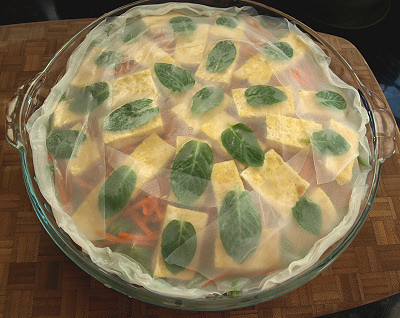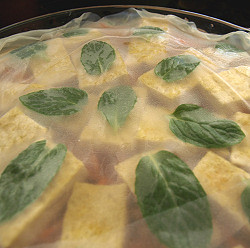
For the rice, I used Lundberg Sweet Brown Rice, but I think any short-grained brown rice would be fine. Word to the wise: I strongly advise against following Lundberg's directions on the rice-to-water ratio. I used a 1:2 ratio per the package instructions, and my rice came out like soupy porridge. I had to start over and make a new batch for the salad and was pretty annoyed with myself for not having gone with my gut! I did the second batch with a 1:1.5 ratio (i.e. 1 cup rice to 1 1/2 cups water) and I felt it was still a little too much water, but I just put it in a colander and let it drain a bit. You're going for a consistency that's slightly sticky but not overcooked.
For the protein, I used yellowfin tuna that I pan-seared and left rare in the center, but you could certainly use raw tuna or salmon if you can find sushi or sashimi-grade (deemed safe for eating raw). I used one tuna steak that weighed 1/2 lb; I'd say this would be enough for 4 small-ish lunch portions or 2 larger dinner portions. Feel free to up it to 2 steaks if you want it heavier on the protein, but I just went with 4-5 slices per serving. Alternately, what I often do when I make this to take in my lunch is just use good-quality drained canned tuna. You could substitute sautéed or boiled shrimp too, or some grilled tofu.
brown rice sushi salad with seared tuna
2 cups short-grain brown rice
Notes: Furikake is a Japanese rice seasoning. It comes in different flavors but always contains sesame seeds and shredded dried seaweed. Sushi vinegar is "seasoned" rice vinegar that has sugar and salt added to it. If you can't find it, just dissolve 1 tsp sugar and 1/2 tsp salt into 4 tbs regular rice vinegar. For the tuna, I would suggest buying it frozen, since the stuff you get at the fish counter has typically been frozen and thawed anyway, even in the "upscale" markets. Trader Joe's has packages of frozen tuna steaks that are reasonably priced. If using 2 tuna steaks for larger portions, I would probably up the rice to 2 1/2 or 3 cups.
sushi vinegar or rice wine vinegar (see notes)furikake seasoning (see notes)
about half a cucumber, seeds scooped out and cut into small matchsticks
1 large carrot, peeled & grated
1 ripe but firm avocado, cut into slices or medium dice
1-2 scallions, thinly sliced on the bias
1 tuna steak (approx. 1/2 lb), thawed if frozen, or 2 if you want bigger portions (see notes)
soy sauce
pickled ginger
wasabi pasteDirections: In a plastic container large enough to hold the tuna, mix together 1/3 cup soy sauce and wasabi to taste. Don't be afraid to go a little on the hot side; the heat will mellow upon cooking. Add a couple tbs of sushi vinegar or mirin (rice wine). Rinse and pat your tuna dry. Leave it to marinate in the soy while you prepare the other ingredients.
Cook the rice. As soon as it's done, stir in 4 tbs sushi vinegar, mixing well. Shake in a generous amount of furikake seasoning, stirring well to incorporate and cool the rice. (If you're unsure how much furikake to use, just add and taste as you go. I tend to use about 1/4 cup.) Set rice aside, covered; you'll want it room-temperature when you assemble your salad.
Heat a small amount of vegetable oil in a heavy skillet (not non-stick) over medium high heat. If you like, you can add a few drops of toasted sesame oil. When the oil is hot, place the tuna in the pan and cook undisturbed for about 2 minutes (3-4 minutes if you don't eat it rare). Flip and cook the other side for another minute or two (again, longer if you want it less rare). I brushed a little sweet chili sauce on the tuna and coated it with toasted sesame seeds, but honestly it was a little messy and I'd probably skip this next time. Set aside tuna on a cutting board. Pour the remaining marinade in the skillet and cook for a couple minutes to reduce; it should be slightly syrupy. When the tuna has cooled a bit, cut it into slices. If it's cooked past rare, it may fall apart a little when you try to cut it, but it'll still taste good!
You can put the salad together two different ways: when making this for a lunch to take to work, I just toss the carrot, cucumber, tuna and avocado in with the rice, along with some julienned pickled ginger, and sprinkle a little soy sauce on top. For a slightly fancier presentation, you can put little clumps of each ingredient on top of a bed of rice, with a few tuna (or salmon) slices fanned over the top (as in the photo). Drizzle some of the soy/pan juices on top and sprinkle with some of the scallion.

 My intended submission to the
My intended submission to the 